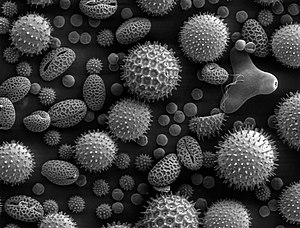Rhinitis
| Rhinitis | |
|---|---|
 |
|
| Pollen grains from a variety of common plants can cause hay fever. | |
| Pronunciation |
|
| Classification and external resources | |
| Specialty | Infectious disease, allergy and immunology |
| ICD-10 | J00, J30, J31.0 |
| ICD-9-CM | 472.0, 477 |
| OMIM | 607154 |
| DiseasesDB | 26380 |
| MedlinePlus | 000813 001648 |
| eMedicine | ent/194 med/104, ped/2560 |
| MeSH | D012220 |
Rhinitis, also known as coryza, is irritation and inflammation of the mucous membrane inside the nose. Common symptoms are a stuffy nose, runny nose, sneezing, and post-nasal drip.
In rhinitis, the inflammation of the mucous membrane is caused by viruses, bacteria, irritants or allergens. The most common kind of rhinitis is allergic rhinitis, which is usually triggered by airborne allergens such as pollen and dander. Allergic rhinitis may cause additional symptoms, such as sneezing and nasal itching, coughing, headache,fatigue, malaise, and cognitive impairment. The allergens may also affect the eyes, causing watery, reddened, or itchy eyes and puffiness around the eyes. The inflammation results in the generation of large amounts of mucus, commonly producing a runny nose, as well as a stuffy nose and post-nasal drip. In the case of allergic rhinitis, the inflammation is caused by the degranulation of mast cells in the nose. When mast cells degranulate, they release histamine and other chemicals, starting an inflammatory process that can cause symptoms outside the nose, such as fatigue and malaise. In the case of infectious rhinitis, it may occasionally lead to pneumonia, either viral pneumonia or bacterial pneumonia. Sneezing also occurs in infectious rhinitis to expel bacteria and viruses from the respiratory system.
Rhinitis is very common. Allergic rhinitis is more common in some countries than others; in the United States, about 10%–30% of adults are affected annually.
...
Wikipedia
